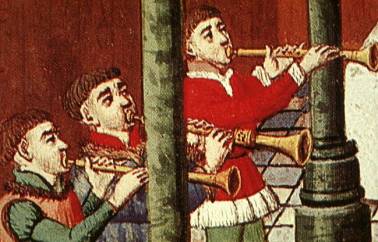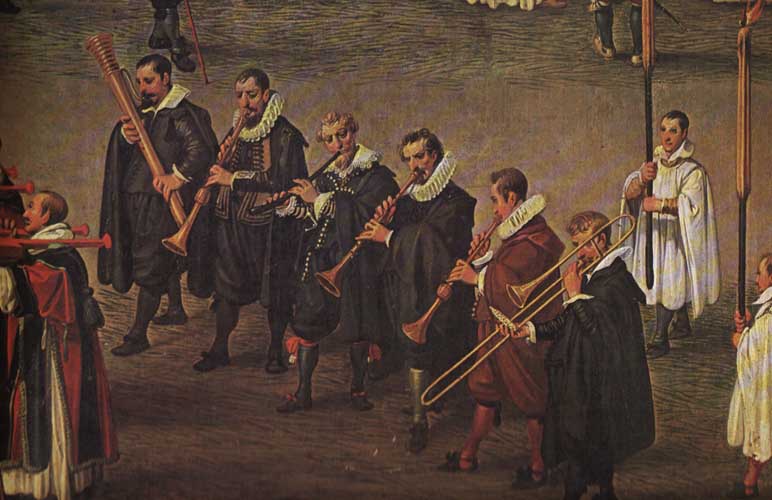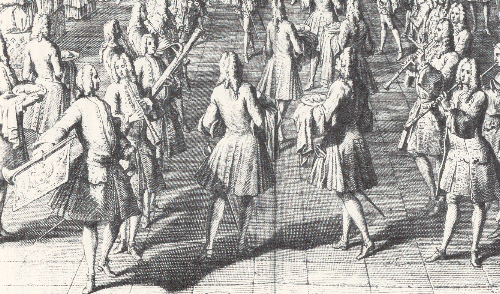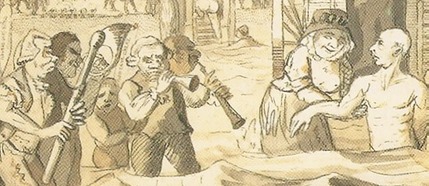Syrinx performs a repertoire spanning several centuries on a range of historical double reed instruments. Here is a little bit of information about the instruments we play – shawms, dulcians, oboes and bassoons – and their development over the course of time.
MIDDLE AGES
 Shawms were imported into Europe from the Middle East at the beginning of the Middle Ages. They became an important part of musical life from the 14th century onwards. Three part shawm bands called the Alta Capella provided ceremonial and dance music at every major court in Europe. Many towns also had a group of wind players called Waits, Stadtpfeifer or Piffari marking the hours of the clock and providing public entertainment at significant points in the social calendar.
Shawms were imported into Europe from the Middle East at the beginning of the Middle Ages. They became an important part of musical life from the 14th century onwards. Three part shawm bands called the Alta Capella provided ceremonial and dance music at every major court in Europe. Many towns also had a group of wind players called Waits, Stadtpfeifer or Piffari marking the hours of the clock and providing public entertainment at significant points in the social calendar.
RENAISSANCE
During the renaissance, instrument building techniques (and particularly metal work) improved to the point where larger instruments could be constructed. Tenor and bass shawms became more common. Large instruments became a status symbol with only the very wealthy in possession of a very high ceiling able to buy a contrabass shawm.
The problem of how to create a sixteen foot pitch wind instrument that wasn’t sixteen feet high was eventually resolved with the invention of the dulcian. The bore of this new instrument doubled back on itself, halving its length and making it much more portable and user-friendly.
 The introduction of the dulcian (or curtal) broadened the spectrum of sound in the reed band. While still a resonant and loud instrument it had a sweeter and softer tone than the shawm family and was capable of a greater range of dynamics and articulation.
The introduction of the dulcian (or curtal) broadened the spectrum of sound in the reed band. While still a resonant and loud instrument it had a sweeter and softer tone than the shawm family and was capable of a greater range of dynamics and articulation.
BAROQUE
Shawms and dulcians continued to be played well into the 18th century but tastes were changing; in France Louis XIV’s court set new standards of luxury and extravagance and royalty everywhere copied his taste in furniture, garden design, food, art, and music. Lully was the the King’s composer of choice and his music demanded a new style of wind instrument. The oboe, invented by members of the elite and highly paid double reed ensemble Les Douze Grands Hautbois, had a larger compass, greater dynamic range and blended easily with strings.
 It soon caught the attention visiting aristocracy; across Europe orders were placed for these fashionable new instruments, and double reed bands sprang up to perform at civic occasions, society dinners, coronations, masques and other spectacular events. Handel’s Water and Fireworks Music was typical of these extravagances, but far from unique.
It soon caught the attention visiting aristocracy; across Europe orders were placed for these fashionable new instruments, and double reed bands sprang up to perform at civic occasions, society dinners, coronations, masques and other spectacular events. Handel’s Water and Fireworks Music was typical of these extravagances, but far from unique.
THE CLASSICAL HARMONIE ENSEMBLE
Wind music was still popular well into the mid 19th century. The oboe band expanded to include horns and clarinets and sextets and octets became the standard grouping, even reaching 21 parts for the coronation of Kaiser Joseph II. The most prestigious groups consisted entirely of virtuosi, but less wealthy patrons had to make do with assorted footmen and other servants with patchy musical training and ability.
A typical Harmonien was a multi-purpose ensemble suitable for outdoor performances as well as intimate soirées. The repertoire included everything from simple background music and innumerable arrangements of entire operas and symphonies, to monumental works of art music, such as Mozart’s Gran Partita. The sound of the ensemble is unmistakably Eastern European in origin—Haydn, Mozart, Beethoven, Weber, and Schubert were all seduced by its rustic exuberance, and later composers like Dvorak, Strauss, Janacek and Stravinsky were understandably inspired to write for similar forces.
